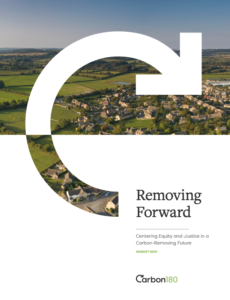Full Title: Removing Forward: Centering Equity and Justice in a Carbon-Removing Future
Author(s): Ugbaad Kosar, Vanessa Suarez
Publisher(s): Carbon180
Publication Date: August 13, 2021
Full Text: Download Resource
Description (excerpt):
Before many environmental organizations began sounding the alarm on climate change, environmental justice (EJ) groups had been warning the public that pollution was harming Black, Indigenous, and other communities of color and low-income communities.
Activists and researchers have shown how these groups face disproportionate levels of exposure to dangerous chemicals, poorer air and water quality, and greater risk from the devastating impacts of natural disasters. Climate change will only exacerbate these conditions, deepening these inequities locally and globally. Despite this, climate efforts to date have largely ignored legacy pollution and non-climate impacts that harm these communities in favor of a narrow focus on mitigating greenhouse gas emissions.
There’s a real risk that carbon removal solutions — a necessary tool to meet climate goals — will follow a similar path of sustaining extractive relationships with disadvantaged communities. It will be incredibly important in the coming years to identify how to scale up carbon removal in a way that aligns with EJ priorities and distributes its benefits. Fortunately, the field is still in an early enough stage to integrate equity and justice into research, development, and deployment.
The Biden administration signaled a strong commitment to EJ by releasing a series of executive orders (EOs), establishing a number of advisory councils, and appointing justice advocates to high-profile positions across the government. Similarly, there has been definitive interest in pursuing carbon removal across land- and technology-based solutions from both Congress and the administration. However, there remains tension within the government on the role of carbon removal as it relates to EJ. To date, many feel that the benefits to disadvantaged communities have not been demonstrated and are therefore not supported. Establishing a coherent and cohesive federal carbon removal strategy that addresses these important concerns will be key to scaling up these technologies and practices in a timely, durable, and sustainable manner.
The greatest opportunity to influence carbon removal is through the federal government. The government can address major information gaps, establish robust safeguards for project implementation, strengthen community-government engagement, and hold actors accountable through legislative and agency actions. This report shares a series of recommendations that span land- and technology-based approaches and are organized by labor and economic opportunities, outreach and engagement, technical and financial assistance, research, development, and deployment (RD&D), and regulations.
